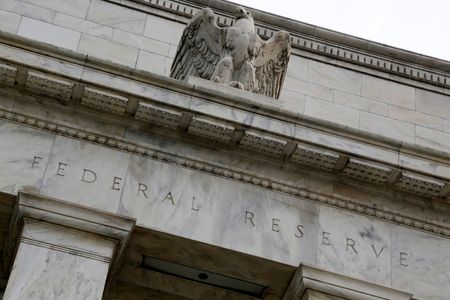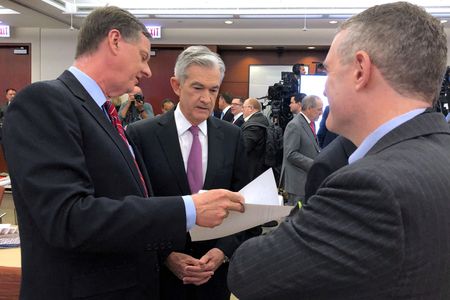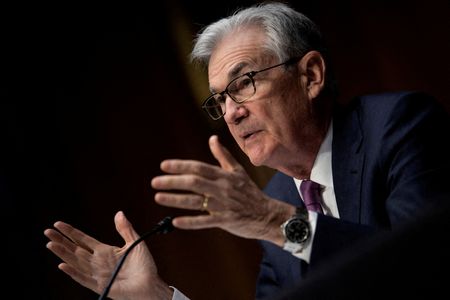


By Lindsay Dunsmuir and Ann Saphir
(Reuters) -Federal Reserve officials are helping shape market expectations for sharper interest-rate hikes to curb the surge in inflation, but have not managed to dispel fears the tightening cycle could blow a hole in the economy and labor market.
“The Fed needs to move aggressively to keep inflation under control,” St. Louis Fed President James Bullard told Bloomberg TV on Tuesday, calling for the central bank to raise its benchmark overnight interest rate to 3% this year. “Faster is better.”
Bullard has made that point before, and dissented last week as the rest of his colleagues last week agreed to raise the federal funds rate by just a quarter of a percentage point from the near-zero level it had been since March 2020.
His view now appears to be gaining traction.
On Monday, Fed Chair Jerome Powell said the central bank must move “expeditiously” to raise rates. When asked what would prevent the central bank raising rates by half a percentage point at the May 3-4 policy meeting, he responded: “Nothing.”
Cleveland Fed President Loretta Mester, in remarks late Tuesday that echoed Powell’s concerns about Russia’s Ukraine war pushing up on already too-high inflation, also expressed support for big rates hikes in coming meetings.
“I find it appealing to front-load some of the needed increases earlier rather than later in the process because it puts policy in a better position to adjust if the economy evolves differently than expected,” she said.
By year end, Mester said, rates should be about 2.5%; with only six more Fed meetings this year, that would require a couple of half-point increases. She said rates need to rise further next year to bring inflation down.
San Francisco Fed President Mary Daly, among the more dovish of the U.S. central bank policymakers, was not asked about a possible half-point rate hike in a virtual event at the Brookings Institution earlier Tuesday.
But she did say she wants to march rates higher, to a neutral level and perhaps above, to prevent high inflation from getting embedded
All said they believed higher borrowing costs could also cool super-hot demand for labor without biting into jobs growth.
The comments have prompted a flood of bets in futures markets on half-point interest rate increases in May and June. Traders now see the federal funds rate rising to the 2.25%-2.5% range by the end of the year – short of Bullard’s view but higher than the 1.9% suggested by Fed forecasts last week.
Powell said the economy is strong enough to withstand higher borrowing costs without damaging the labor market and argued the best thing the Fed could do to ensure continued labor market strength is to get inflation under control.
But traders are now also building bets that the Fed will start cutting interest rates by 2024, pricing of futures contracts shows.
“The fixed income market squarely does not believe Powell’s economic optimism: It is telling us that a soft landing, if the Fed goes down Powell’s path, will not only be challenging – it will be impossible,” wrote Roberto Perli, an economist at Piper Sandler.
‘HAWKISH PIVOT’
It’s shaping up to be a rocky start for the Fed’s first round of rate hikes in three years, and particularly for the way its policymakers are communicating it.
Ahead of last week’s interest rate increase, Powell had said the Fed would proceed “carefully” due to high uncertainty about the impact on the U.S. economy of the Russian invasion of Ukraine.
In his news conference following the release of the Federal Open Market Committee (FOMC) policy statement and projections, Powell said the Fed must be “nimble” in responding to the evolving outlook.
And this week the Fed chief downplayed worries over the potential dent to economic growth and focused far more sharply on the likelihood the war in Ukraine could worsen U.S. inflation, which has hit a 40-year high and is about three times the central bank’s 2% target.
The changes, wrote NatWest economist Kevin Cummins, could reflect Powell’s ongoing personal “hawkish pivot” that began in late 2021.
“In the near-term, Powell’s comments are obviously not the last word as for the size of the expected rate hike in May, especially since the May FOMC meeting is not for another six weeks and Fed actions will be driven by the data,” Cummins wrote.
(Reporting by Lindsay Dunsmuir and Ann Saphir; Editing by Paul Simao and Richard Pullin)

